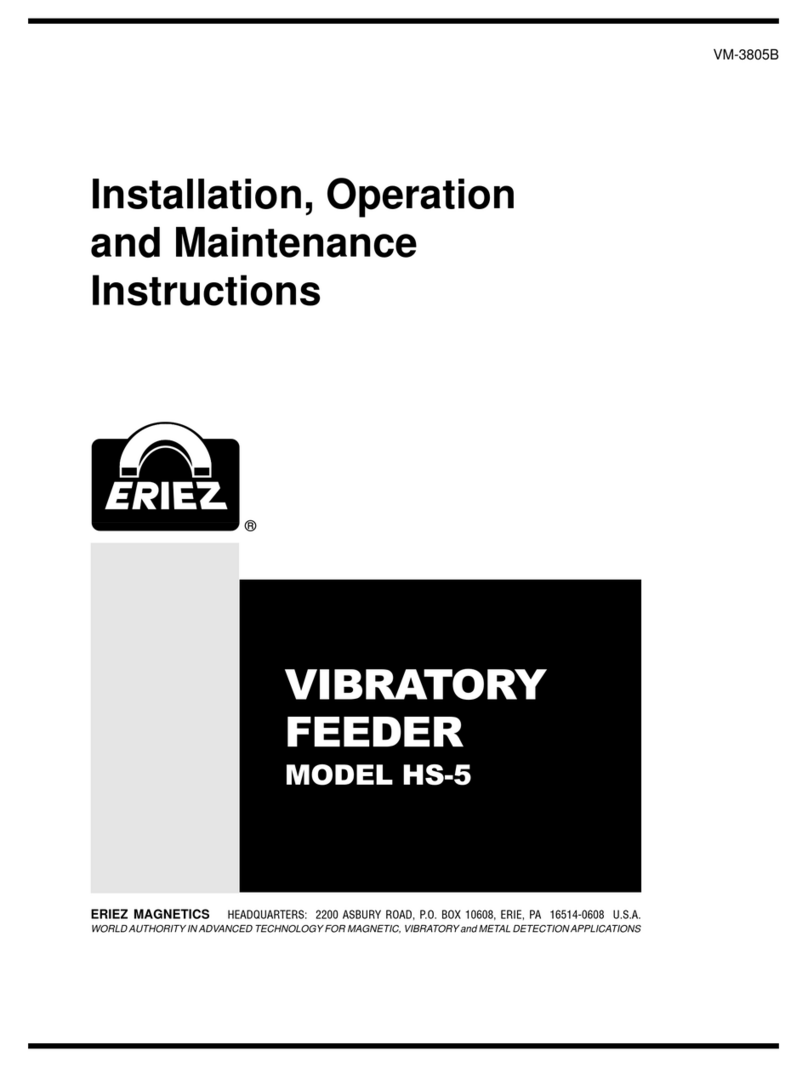Eriez TMR Manual

Installation, Operation
and Maintenance
Instructions
ERIEZ MAGNETICS HEADQUARTERS: 2200 ASBURY ROAD, ERIE, PA 16506–1402 U.S.A.
WORLD AUTHORITY IN SEPARATION TECHNOLOGIES
VM-3651
VIBRATING
FEEDERS &
CONVEYORS
MODEL TMR
VIBRA-
TORY
FEEDER
MODEL HS36

2
CAUTION
Safety labels must be affixed to this product.
Should the safety label(s) be damaged, dislodged
or removed, contact Eriez for replacement.
WARNING
Suspension mounting inherently involves risk of
damage to property or injury to personnel located
under or near the equipment, should a suspension
component fail. As with all suspended equipment,
access to the area under this machine should be
restricted. Specifications for suspension components
given in this manual are suggestions only, and the
user is entirely responsible for final selection of
suspension method and details. Select and properly
use suspension components with rated capacities
(including all appropriate reduction factors) that
provide adequate safety when the weight of the
equipment and all possible loading conditions
and upsets are taken into account. Consult Eriez
at 814-835-6000 if additional information regarding
Eriez equipment is needed to make this selection.
Introduction
This manual details the proper steps for installing,
operating and maintaining the Eriez Mechanical
Vibrating Feeder/Conveyor.
Careful attention to these requirements will assure the most
efficient and dependable performance of this equipment.
If there are any questions or comments about the manual,
please call Eriez at 814-835-6000 for Conveyor assistance.
©2015 ERIEZ MAGNETICS ALL RIGHTS RESERVED

Vibrating Feeder & Conveyor: Model TMR
3
Table of Contents
ERIEZ VIBRATING FEEDER/CONVEYOR - MODEL TMR
INSTALLATION
Damage in Shipment ....................................................................................... 4
Handling .......................................................................................................... 4
Installation Procedures .................................................................................... 4
Wiring .............................................................................................................. 4
OPERATION AND MAINTENANCE
Principle of Operation ...................................................................................... 5
Special Troughs & Attachments....................................................................... 5
Deflection......................................................................................................... 5
Adjustment of Force Output............................................................................. 6
Adjustment by Adding/Removing Springs ....................................................... 6
Spring Replacement ........................................................................................ 6
Lubrication ....................................................................................................... 7
Motor Replacement ......................................................................................... 7
Maintenance Tables......................................................................................7-8
PARTS LIST .......................................................................................................... 9
TROUBLESHOOTING ........................................................................................ 10

4
Installation
Damage in Shipment
When you receive your conveyor, examine
it carefully for damage. If damage is found,
report it immediately to Eriez Magnetics
and the freight carrier.
Handling
It is important to handle this equipment carefully
to avoid twisting or bending the frame or pans.
If lift lugs are provided, they must be used;
otherwise, lift with slings wrapped below the
conveyor base. Do not lift by the tray.
A spreader board over the pan should be used to
prevent your chain or cable from bending the pan
while lifting.
An excessively large amount of weight placed
on the pans or springs could damage the unit.
Installation Procedures
Conveyors are arranged for either base or
suspension mounting. Base pads should be
fastened to floor or framework to maintain conveyor
position. Adequate space must be provided between
pan and/or base with any surrounding solid object
to prevent interference. Conveyors arranged for
suspension mounting should be hung from the base
using eyebolts with rubber or steel coil isolation
springs as provided by Eriez. See Figure 1.
The isolation assemblies should be welded to
suitable overhead structure. Wire rope and/or
turnbuckles may be used for greater suspension
height. Tension on all suspension parts should be
equal. Conveyors are normally mounted horizontal
but can be mounted up to 10 degrees downslope.
In this position, velocity of 80 feet per minute
(24 mpm) can be obtained, depending on material
characteristics. If feeding conveyor from storage
hopper, care must be taken to minimize headload.
Wiring
Wiring to the motor should enter from a flexible
conduit. Use of a motor starter and circuit protection
is recommended. Wiring must be properly sized to
prevent line voltage drop.
Motors commonly supplied are 900 rpm, dual
voltage polyphase. Connect wiring according to
the manufacturer's instruction, usually located on
the nameplate or in the conduit box cover.
Motor rotation should be such that the left and
right motors spin in the opposite direction from
each
other. See Principle of Operation on next page.
When controller is supplied, connect according
to instructions enclosed with this equipment.
FIGURE 1
TYPICAL ERIEZ MODEL TMR

Vibrating Feeder & Conveyor: Model TMR
5
Special Troughs & Attachments
Eriez Engineering Service Department should always
be consulted before undertaking the design or
construction of special troughs. The troughs as
furnished by Eriez should not be modified or attach-
ments added without first consulting Eriez, as the
feeders and conveyors are a tuned two-mass system
and damage will result. To do so will void the warranty.
Deflection
Eriez TMR conveyors are normallly set at approxi-
mately 7/16" (11 mm) pan deflection or otherwise
stated on outline drawing. This can be checked with
an Eriez deflection sticker. The sticker is read while
the equipment is operating by looking at the optical
illusion in which the printed circles appear as
double. Read the deflection where the two circles
touch. A deflection sticker is shown in Figure 3.
The deflection may also be read by holding a
pencil very steadily (resting against a solid object)
and touching the pan side with the pencil point
while the pan is operating. Then, stop the equipment
and measure the deflection indicated by the line
drawn on the side of the pan.
Do not operate with pan deflections greater than
7/16" (11 mm) because spring damage will result.
The total of pan and base deflection must
not exceed 11/16" (18 mm) for TMR conveyors.
This deflection should be taken at full voltage
and with material feeding at maximum capacity.
FIGURE 3
Operation & Maintenance
Principle of Operation
Feeder tray motion is provided by eccentric weights
mounted on synchronized, counter-rotating, twin
motors. The motors are in balance with one another
to eliminate the isolation problems associated with
single eccentric drive systems. Feed rate can be
varied by adjusting the weights. The twin motor
drives operate on standard AC power.
FIGURE 2
Table of contents
Other Eriez Accessories manuals


















